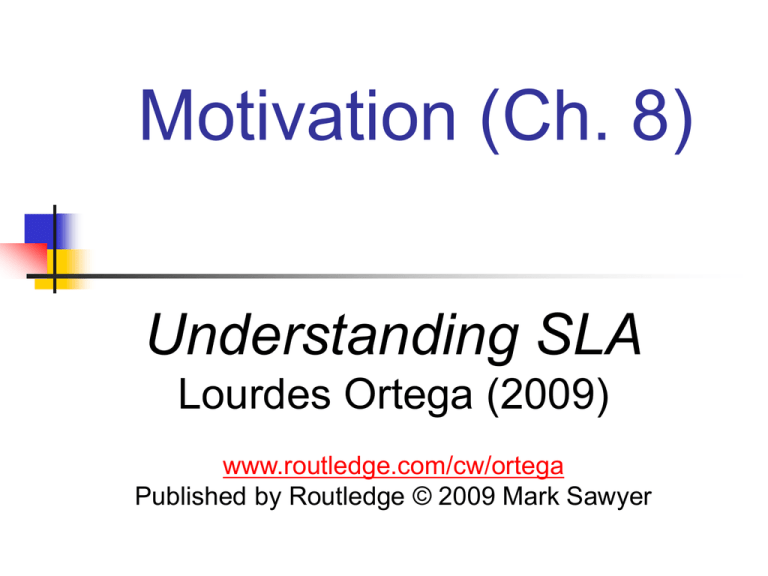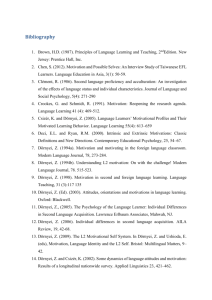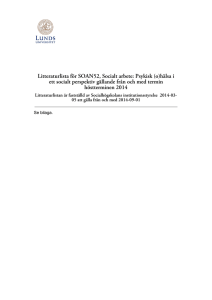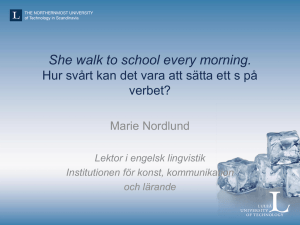USLA Ch 8 powerpoint
advertisement

Motivation (Ch. 8) Understanding SLA Lourdes Ortega (2009) www.routledge.com/cw/ortega Published by Routledge © 2009 Mark Sawyer The traditional approach: AMTB & motivational quantity (8.1) Motivation narrowly defined (Gardner) 1. 2. 3. Effort (Motivational intensity) Enjoyment (L2 learning attitudes) Investment (Desire to learn L2) Quantity measured by Likert scales “Truly motivated individual” high in all 3 Unlike Kaplan, Watson lacks enjoyment Integrativeness as an antecedent of motivation (8.2) Integrativeness = Favorable attitudes toward L2 NSs General interest in FLs (+ low ethnocentrism?) Integrative orientation Integrative motivation (subsystem) = Integrativeness is high MOT (quantity) is high Other antecedents: Orientations & attitudes (8.3) Widely reported orientations (reasons) Instrumental Knowledge Travel Friendship Integrative Additional orientations Among Anglophone Canadians Dominance/recognition Pragmatic control Familiarity/involvement Sociocultural/belletristic (Clément & Kruidenier) Attitudes Come from collective values, beliefs Based on cultural reward, modeling Specific to sociocultural milieu HS attitudes U MOT, integrativeness (Indirectly) U attitudes toward BiL, perceived communicative competence Attitudes, experiences MOT (Gardner) First signs of renewal (8.4): Self-determination theory & intrinsic motivation Types of regulation of behavior Internal (intrinsic MOT) Stimulation Self-accomplishment Knowledge Identified (positive self-image) Introjected (guilt/shame) External (extrinsic MOT) 8.5 Motivation from a distance: EFL learners’ orientations & attitudes Orientations in Hungary (Clément et al.) friendship/knowledge xenophilic instrumental/knowledge L2 media/indirect contact/cultural interest Attitudes in Japan: International Posture (Yashima) Interest in int’l vocation/activities Intercultural approach tendency Interest in foreign affairs 8.6 Language learning motivation: Possible in situations of conflict? Israeli L2 learners (Donitsa-Schmidt et al.) Early starters of L3 Arabic JHS learners of Arabic vs. other L3s More culture/peace/instrumental beliefs More MOT/+ attitudes toward L3, speakers Choice of L3 made no difference Both groups: teachers, instruction impt. 8.7 Dynamic motivation: Time, context, behavior Process model of MOT (Dörnyei & Ottó) Causal vs. teleological MOT thinking (Ushioda) Experience-based vs. Goal-oriented Micro-context, task (Dörnyei) MOT develops, changes over time Integrativeness & + course attitude + task attitude L2 output + peer attitudes also help for – task attitude New focus on behavior (Csizér & Dörnyei) e.g. language choice, intended effort 8.8 Looking forward: L2 motivational self system Components 1. Ideal L2 self (e.g. nativelike speaker) 2. Ought-to L2 Self (e.g. mustn’t fail exam) 3. L2 learning experience (past/present) Process Instrumentality + Attitudes to L2 group Ideal L2 Self (new Integrativeness) 8.9 Behold the power of motivation Gardner’s research: Dörnyei’s new research: MOT predicts 9-16% of achievement MOT predicts 35% of behavior (?) Caution: MOT/L2 success relationship is reciprocal rather than causal


